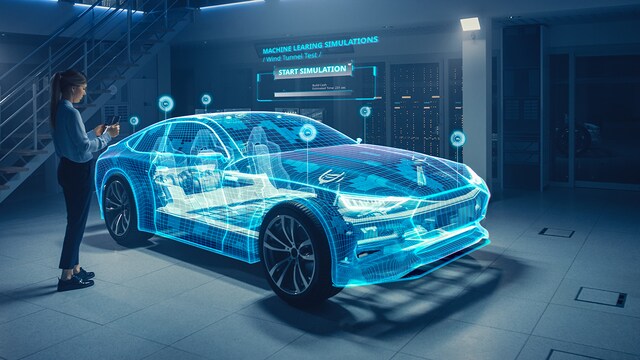The automotive industry is on the brink of transformative change, with the next three years set to bring more advancements than the previous decade. As cars evolve into smarter, safer, and more efficient machines, software and digital technologies are driving this revolution, reshaping vehicles from the ground up. Key trends such as software-defined vehicles, autonomous driving, and electric vehicles (EVs) are emerging simultaneously, guiding the industry toward a new era of innovation.
This rapid evolution is opening up new avenues for differentiation in a highly competitive market. However, it also presents challenges, such as talent shortages in software and integrated chip development, and the need for significant investment in infrastructure and technology. In this article, we explore the critical areas where technological transformation is impacting the automotive industry and the innovative strategies stakeholders are adopting to stay ahead of the curve.
Autonomous Driving Revolution: AI and Sensors Transform Vehicle Safety
Autonomous driving stands out as one of the most groundbreaking developments in automotive history. Advances in artificial intelligence (AI), sensor technology, and high-speed connectivity are bringing us closer to a future where self-driving cars are the norm. These advancements are also increasing the demand for software-defined vehicles that can receive remote updates to introduce new functions and features, such as enhanced driver assistance, advanced safety systems, and improved connectivity and infotainment options. This evolution promises to make driving safer and more convenient while creating new opportunities for innovation.
Autonomous driving depends heavily on a complex sensor stack and sensor fusion technology, which act as the vehicle’s perceptive systems, or “eyes and ears.” This technology includes LiDARs, radars, cameras, ultrasonic sensors, and GPS data, all of which work together to give vehicles a comprehensive understanding of their surroundings. By combining data from all these sensors, vehicles can create a more accurate environmental model, improving their decision-making and task execution capabilities. This process, known as sensor fusion, is crucial for enabling cars to navigate their environments efficiently.
Continuous advancements in sensor fusion algorithms, powered by AI, are enhancing object classification, scenario interpretation, and hazard prediction. These improvements are essential for real-time driving decisions and safety, making autonomous driving not only possible but also reliable. The rise of autonomous driving represents a significant shift in the industry, promising safer roads and more leisure time for drivers. However, it also demands rigorous testing and close regulation, as manufacturers and tech giants work to lay the foundation for the future of mobility and redefine transportation.
Streamlining Vehicle Complexity with Advanced Control Systems with Zonal Architecture
As vehicles become increasingly complex, the industry is transitioning toward a zonal architecture, which organizes vehicles into physical zones rather than functional domains. In this model, multifunctional zonal controllers manage different workloads, all of which are connected via a high-speed, in-vehicle network to a powerful central computing unit. These zonal controllers can pre-process sensor data, acting as data aggregators, or pass unfiltered sensor data to the central computing unit for sensor fusion. The central unit then uses powerful AI-based algorithms to process large amounts of data in real time, enabling smarter decision-making.
Machine learning algorithms play a crucial role in this architecture by processing extensive sensor data in the cloud, retraining neural networks, and deploying updated AI software to the central computing unit. This process enhances object identification and classification, improving vehicle safety and efficiency in complex driving environments.
Over the past decade, the number of electronic control units (ECUs) in vehicles has increased dramatically due to the introduction of new functions. Zonal controllers, with significantly more processing power than traditional microcontrollers, can run multiple functions in parallel, allowing original equipment manufacturers (OEMs) to consolidate distributed ECU functions. As a result, zonal architecture helps reduce the number of ECUs and simplifies the wiring harness, leading to lighter, more energy-efficient vehicles while enabling sophisticated autonomous and connected features.
High-Bandwidth Networks Drive Automotive Innovation Amid Rising Cyber Risks
The next generation of electrical and electronic (EE) architectures in vehicles requires high-bandwidth, in-vehicle networking to support the increasing demand for connectivity and autonomy. As cars become more connected, reliable high-speed data transfer between systems becomes essential. Ethernet-based in-vehicle networks offer significantly higher bandwidth and better scalability than traditional protocols like CAN and FlexRay, allowing OEMs to create a more homogeneous network based on open standards. This enables high-speed, end-to-end communication within vehicles.
OEMs are beginning to implement standards-based Serializer/Deserializer (SerDes) Physical Layer (PHY) interfaces to connect high-resolution sensors with zonal controllers, enabling sensor pre-fusion or data aggregation. Scalable, multi-gigabit SerDes interfaces, such as ASA Motion Link and MIPI A-PHY, are designed to meet the complex requirements of automotive applications, providing asynchronous, high-reliability, and low-latency data transfers over long-reach wiring.
However, the increase in connectivity and automation also raises cybersecurity concerns. Vehicles, often described as “computers on wheels,” are vulnerable to hacking. To protect against such threats, manufacturers must prioritize robust cybersecurity measures, including multi-layered security approaches at the networking layer (e.g., MacSec) and hardware isolation techniques within ECUs (such as hardware security modules).
Software Revolutionizes Vehicles with OTA Updates and Digital Cockpits
In the future, software will play an increasingly important role in the automotive industry, enabling the addition or upgrade of functionalities via software updates rather than requiring changes to physical hardware. Multiple functions will be controlled by software running on powerful general-purpose processors, rather than by a single function controlled by a dedicated microcontroller. Software-defined vehicles allow for remote updates, feature customizations, and seamless connections to other devices. Over-the-air (OTA) updates reduce the need for physical service visits, ensuring that vehicles stay up-to-date with the latest advancements and security patches.
Fully configurable digital cockpits are another key development, integrating vehicle information and controls into a single interactive display. These cockpits offer entertainment, navigation, safety, and comfort features that can be customized to the driver’s preferences. Voice-activated controls and AI capabilities further enhance the driving experience for both human-driven and autonomous vehicles.
However, this digital transformation also creates a demand for new skills in software development, chip design, and digital integration. Manufacturers are investing in training and collaborating with technology companies to ensure they remain at the forefront of these developments.
Semiconductors Drive Automotive Innovation Amid Chip Shortages and Advances
Semiconductors are at the heart of modern vehicles, powering everything from infotainment systems to battery management. Many of the industry’s recent innovations are made possible by high-performance chips capable of running demanding software applications and AI algorithms. The recent chip shortage underscored the need for resilient supply chains, while emerging semiconductor technologies, such as chiplets, offer potential solutions to these challenges.
Specialized system-on-chips (SoCs) are being developed to process vast amounts of sensor data, which is essential for future mobility solutions. The automotive industry is aggressively pursuing cutting-edge chip technologies, recognizing them as a key battleground for innovation. OEMs are forming strategic partnerships for semiconductor development, requiring significant investment and careful risk management.
Vertical Integration and EDA Solutions Transform Automotive Semiconductor Strategies
As more vehicle functions are realized in silicon, OEMs and top-tier suppliers are adopting new strategies to establish their roles in semiconductor and software development. The trend toward vertical integration reflects a desire for better control over quality and innovation. However, this shift also presents challenges, including the need to manage internal complexity and maintain expertise across various domains.
The traditional automotive supply chain may need to be reconfigured to support this shift. To do so, new strategic partnerships and collaborations must be formed to integrate critical technologies and capabilities vertically. This approach will help OEMs and tier-one suppliers differentiate themselves in the future and mitigate the risks associated with chip supply shortages. Achieving vertical integration requires OEMs to take ownership of additional strategic components, such as ECU or chip development. However, this approach demands significant investment and careful risk management.
The electronic design automation (EDA) industry is playing a crucial role in enabling automotive digital transformation by providing advanced EDA solutions, semiconductor intellectual property (IP), and chip development services. These new offerings are facilitating automotive innovation and accelerating the industry’s trajectory toward digital integration.
Conclusion: Technological Revolution Drives Future of Smarter, Safer Automotive Innovations
The integration of new technologies is revolutionizing the automotive industry, driving unprecedented change and innovation. Autonomous driving, zonal architecture, high-speed in-vehicle networks, digital transformation, and advanced chip development are all key areas where this transformation is taking place. As OEMs and suppliers navigate these changes, strategic partnerships, vertical integration, and a focus on cybersecurity will be essential to maintaining a competitive edge and ensuring the safety and reliability of next-generation vehicles.
In the coming years, the automotive industry will continue to evolve rapidly, driven by the relentless pace of technological innovation. By embracing these changes and investing in the necessary infrastructure, skills, and partnerships, stakeholders can position themselves to lead the industry into the future, creating smarter, safer, and more efficient vehicles for the road ahead.
Citations from an article by Cadence Design Systems








